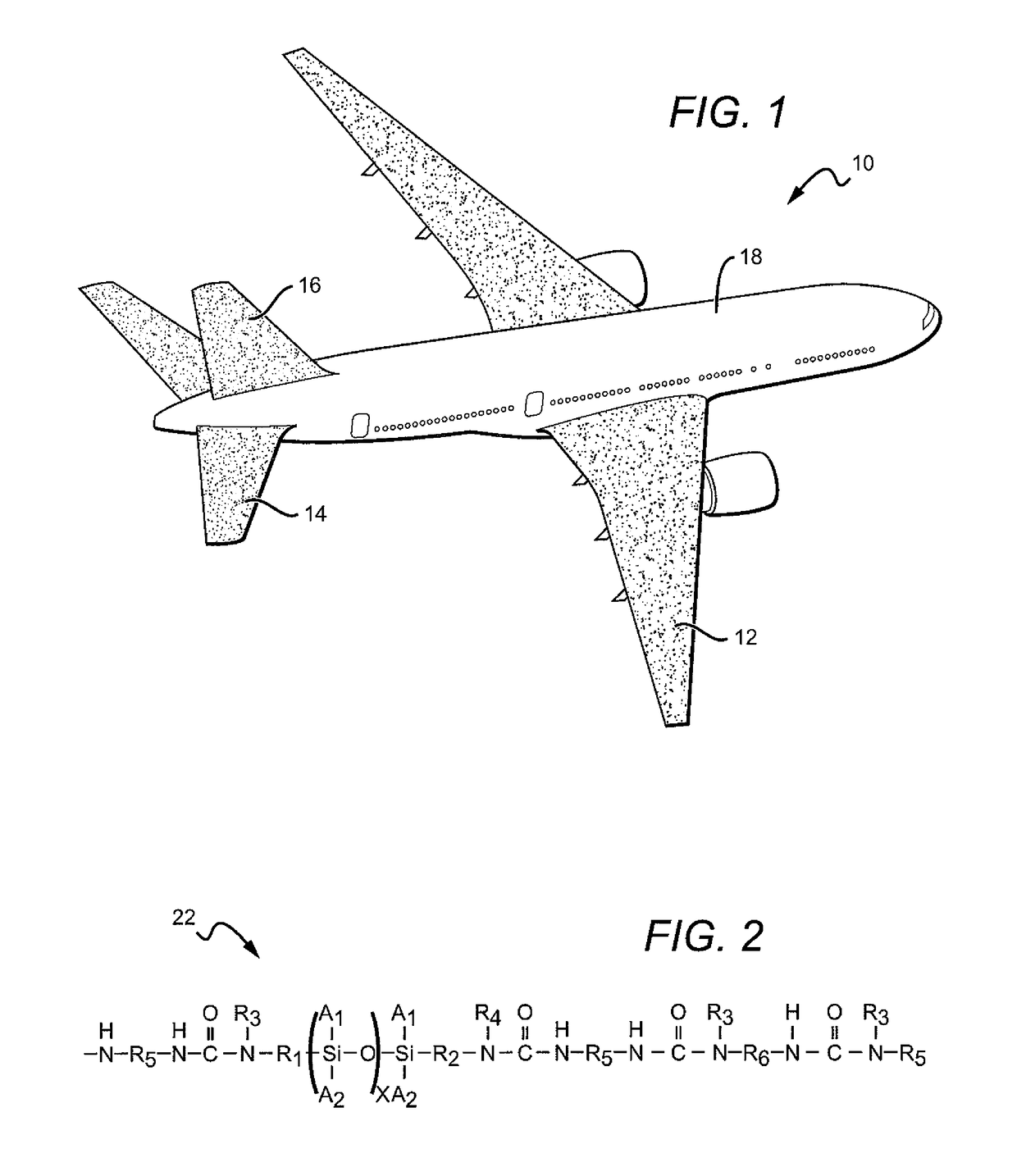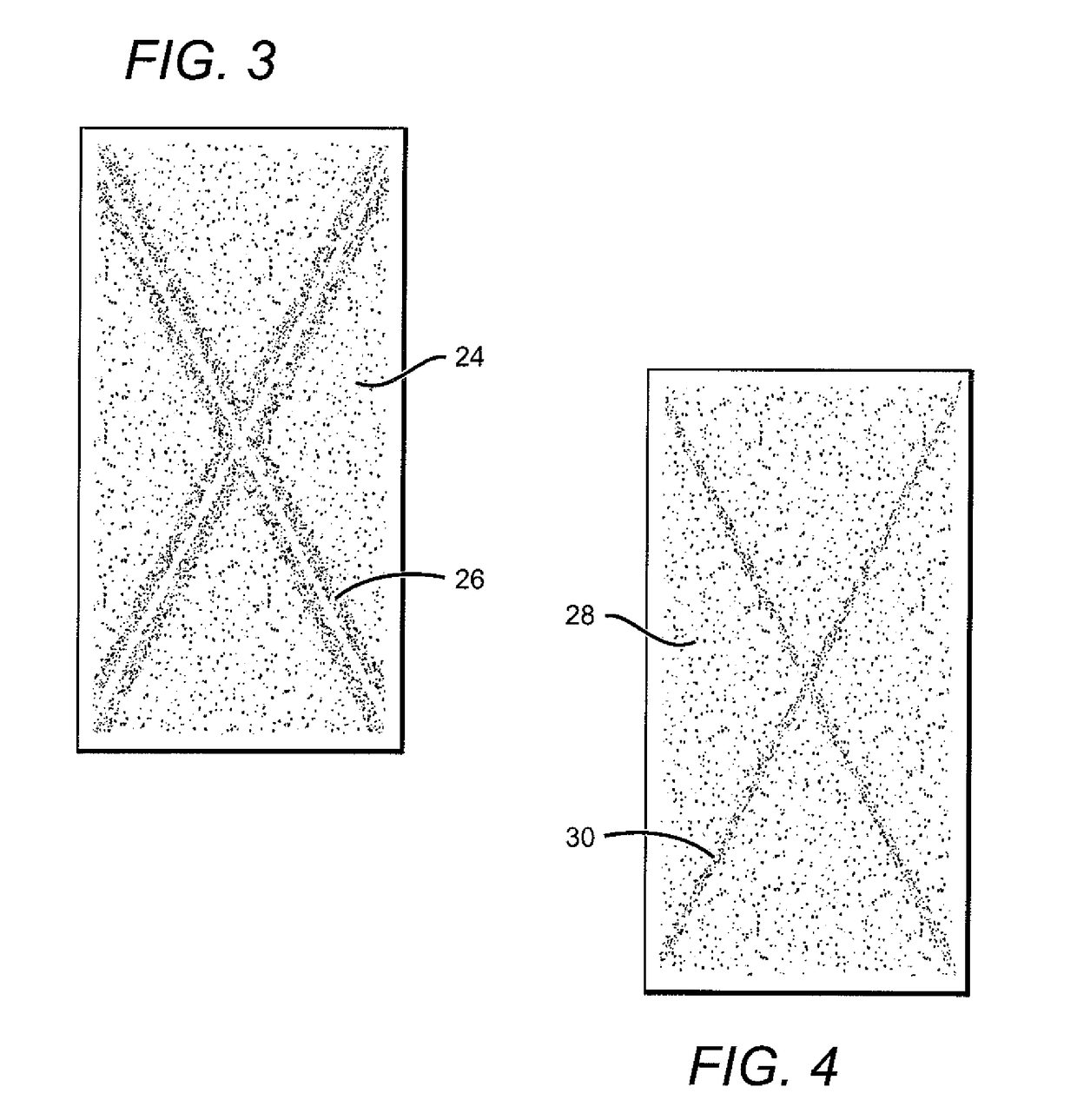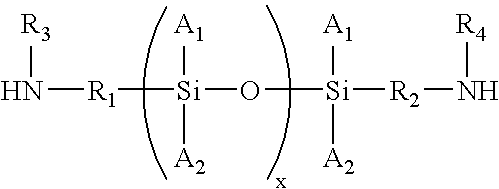Composition and method for corrosion protection of a structure
a structure and composition technology, applied in the field of polymer coatings, can solve the problems of not being able to provide all compositions and methods, and achieve the effects of reducing water adsorption, weakening water hydrogen bonding, and enhancing corrosion protection of substrate surfaces
- Summary
- Abstract
- Description
- Claims
- Application Information
AI Technical Summary
Benefits of technology
Problems solved by technology
Method used
Image
Examples
example 1
(Polymer 1) Polyamide-Urea Synthesis (Typical)
[0091]48.19 g (0.012 m typical) of polysiloxanepropylamine (PS-510) was weighed into a 500 ml round bottom flask and dissolved in 150 ml of methylene chloride (MeCl2). 0.60 g (0.003 m typical) of 4,4′-oxydianaline was weighed into a small beaker and dissolved in 30 ml of MeCl2. This was then added to the PS-510 solution with mixing. The flask was set up with an addition funnel and nitrogen inlet and purged with dry nitrogen for 20 minutes. 1.15 g (0.0075 m typical) of fumaryl dichloride was weighed into a small beaker and dissolved in 30 ml of MeCl2. This was poured into the addition funnel and added drop-wise to the reaction over about 10 minutes. The funnel was rinsed with two 10 ml aliquots of MeCl2. 15 ml of triethylamine was poured into the funnel and also added drop-wise over 10 minutes. The reaction was then allowed to mix for 1 hour. 1.31 g (0.0075 m typical) of 2,4-toluene diisocyanate (TDI) was weighed into a small beaker and d...
example 2
(Polymer 2) Poly Urea Synthesis (Typical)
[0092]48.19 g (0.012 m typical) of polysiloxanedipropylamine (PS-510) was weighed into a 500 ml round bottom flask and dissolved in 150 ml of tetrahydrofuran (THF). 0.60 g (0.003 m typical) of 4,4′-oxydianiline was weighed into a small beaker and dissolved in 30 ml of THF. This was then added to the PS-510 solution with mixing. The flask was set up with an addition funnel and nitrogen inlet and purged with dry nitrogen for 20 minutes. 2.61 g (0.015 m typical) of 2,4-toluene diisocyanate (TDI) was weighed into a small beaker and dissolved in 30 ml of THF. This was poured into the addition funnel and added drop-wise to the reaction over about 10 minutes. The funnel was rinsed with two 10 ml aliquots of THF. The reaction was allowed to mix for 30 minutes then heated to reflux for 1 hour.
example 3
(Polymer 3) Polysiloxane ureide (2,6-diaminopyridine / toluene diisocyanate)
[0093]48.19 g (0.012 m typical) of polysiloxanedipropylamine (PS-510) was weighed into a 500 ml round bottom flask and dissolved in 150 ml of tetrahydrofuran (THF). 0.38 g (0.003 m typical) of 2,6-diaminopyridine was weighed into a small beaker and dissolved in 30 ml of THF. This was then added to the PS-S10 solution with mixing. The flask was set up with an addition funnel and nitrogen inlet and purged with dry nitrogen for 20 minutes. 2.61 g (0.015 m typical) of toluene diisocyanate (TDI) was weighed into a small beaker and dissolved in 30 ml of THF. This was poured into the addition funnel and added drop-wise to the reaction over about 10 minutes. The funnel was rinsed with two 10 ml aliquots of THF. The reaction was allowed to mix for 30 minutes then heated to reflux for 1 hour.
PUM
| Property | Measurement | Unit |
|---|---|---|
| corrosion | aaaaa | aaaaa |
| volume | aaaaa | aaaaa |
| durability | aaaaa | aaaaa |
Abstract
Description
Claims
Application Information
 Login to View More
Login to View More - R&D
- Intellectual Property
- Life Sciences
- Materials
- Tech Scout
- Unparalleled Data Quality
- Higher Quality Content
- 60% Fewer Hallucinations
Browse by: Latest US Patents, China's latest patents, Technical Efficacy Thesaurus, Application Domain, Technology Topic, Popular Technical Reports.
© 2025 PatSnap. All rights reserved.Legal|Privacy policy|Modern Slavery Act Transparency Statement|Sitemap|About US| Contact US: help@patsnap.com



